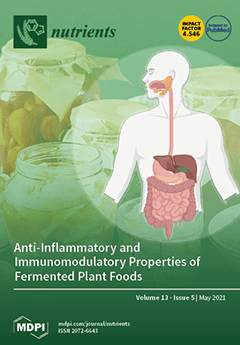Little is known about nutritional factors during weight loss on digital commercial weight loss programs. We examined how nutritional factors relate to weight loss for individuals after 4 and 18 months on a mobile commercial program with a food categorization system based on energy density (Noom). This is a two-part (retrospective and cross-sectional) cohort study. Two time points were used for analysis: 4 months and 18 months. For 4-month analyses, current Noom users who met inclusion criteria (
n = 9880) were split into 5% or more body weight loss and stable weight loss (0 ± 1%) groups. Individuals who fell into one of these groups were analyzed at 4 months (
n = 3261). For 18-month analyses, individuals from 4-month analyses who were still on Noom 18 months later were invited to take a one-time survey (
n = 803). At 18 months 148 participants were analyzed. Noom has a system categorizing foods as low-, medium-, and high-energy-dense. Measures were self-reported proportions of low-, medium-, and high-energy-dense foods, and self-reported nutritional factors (fruit and vegetable intake, dietary quality, nutrition knowledge, and food choice). Nutritional factors were derived from validated survey measures, and food choice from a novel validated computerized task in which participants chose a food they would want to eat right now. ANOVAs compared participants with 5% or more body weight loss and participants with stable weight (0 ± 1%) at 4 months on energy density proportions. Analyses at 18 months compared nutritional factors across participants with >10% (high weight loss), 5–10% (moderate weight loss), and less than 5% body weight loss (low weight loss), and then assessed associations between nutritional factors and weight loss. Individuals with greater weight loss reported consuming higher proportions of low-energy-dense foods and lower proportions of high-energy-dense foods than individuals with less weight loss at 4 months and 18 months (all ps < 0.02). Individuals with greater weight loss had higher fruit and vegetable intake (
p = 0.03), dietary quality (
p = 0.02), nutrition knowledge (
p < 0.001), and healthier food choice (
p = 0.003) at 18 months. Only nutrition knowledge and food choice were associated with weight loss at 18 months (B = −19.44, 95% CI: −33.19 to −5.69,
p = 0.006; B = −5.49, 95% CI: −8.87 to −2.11,
p = 0.002, respectively). Our results highlight the potential influence of nutrition knowledge and food choice in weight loss on a self-managed commercial program. We also found for the first time that in-the-moment inclination towards food even when just depicted is associated with long-term weight loss.
Full article






